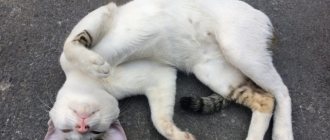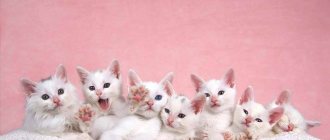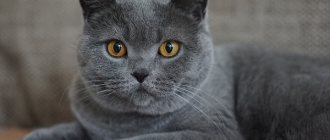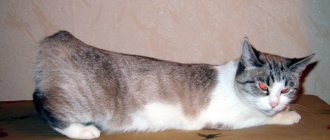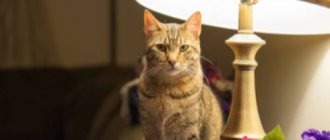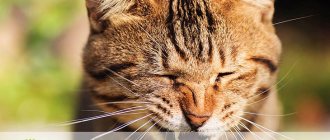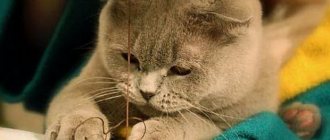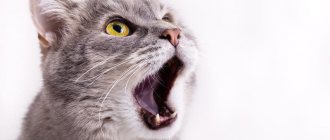Why does a cat always sit in one place?
Your cat always sits in one place to serve two purposes: first, by leaving his scent on the chair, your cat can feel more comfortable resting there, and second, it is also a sign of dominance to ward off other animals.
Don't worry, this doesn't mean your cat thinks you're smelly or anything. If your cat enjoys spending time with you there, "marking" her with a familiar scent will simply ensure that your cat will be comfortable spending many happy hours with you in that place.
© shutterstock
How to understand a cat: sounds
Meow
Meowing can be used to express anything. It can mean a greeting (long time no see!), an order (take it in your arms, let it go, feed it), an objection (better not touch it), an announcement (here’s a mouse for you). Cats use most types of meows to communicate with people, but sometimes it happens that a cat walks around the house and meows to itself.
Purring
With the help of these sounds, the mother cat encourages the kittens to follow her. When a cat makes such a sound towards you, perhaps it is her way of calling you somewhere. Usually towards a plate or toys.
Cats living together often communicate with each other in this way.
Purr
This is usually a sign of pleasure. Cats can always purr with pleasure, even when they eat. But it can also mean a lot of things, from excitement to pain.
Growling, hissing and spitting
And without a translator, it is clear that the cat is very irritated and angry, and it is better to leave it alone.
Howls
This sound can be described as a loud, drawn-out meow. It usually means that the cat is in an unpleasant situation, for example, locked in a closet, looking for you, or something hurts. If you hear howling, you should look for the cat and check if anything has happened to it.
Unneutered cats and female cats make such sounds during the mating season. And in older cats, howling can be a sign of dementia and means that the cat is disoriented.
Are cats more comfortable in the same place?
When your cat consistently sleeps in a favorite spot, she will immediately feel relaxed and comfortable.
Although our sense of smell is not as good as domestic cats, you can compare it to visiting your parents' house. There are certain scents, like mom's cooking, dad's cigars, old books... little things that make you feel more at ease and make you feel at home.
Why does a cat stay in the same place for hours?
If your cat is usually quite playful, then staying in one area for an extended period of time could be a warning sign. This could indicate a number of things such as pain, anemia, shock or even internal bleeding, so a visit to the vet is a good idea (just in case).
Cats certainly like to stay in the same place for long periods of time when they're older, of course, but if your cat is usually quite lively and now seems mostly lethargic, you'll need to get this checked out as soon as possible. to avoid any possible injury or damage.
How to understand a cat: a guide to moods
These clues will help you understand what your cat is currently feeling and what mood she is in.
Lill Chin
Satisfied : sitting or lying, eyes half-closed, pupils constricted, tail almost motionless, ears directed forward, purring. A very happy cat will often stomp her paws on a soft surface, such as your lap.
Playful : Ears point forward, tail raised, pupils slightly dilated (play is a type of hunting behavior).
Irritated or overexcited : Pupils dilated, ears turned back, tail wagging or quivering, may make threatening warning sounds and may bite. After active play, many cats quickly become overexcited, go into a rage and begin to attack, bite and scratch.
Nervous or anxious : ears pointed to the side or back, pupils dilated, tail down or tucked. The cat walks half-bent, pressing against the floor, looking for shelter. In this state, the cat may sit facing the wall so as not to see the outside world.
Frightened or shocked : ears point back, pressed against the head, whiskers pressed to the muzzle, back arched, fur standing on end, tail raised or lowered. The cat may howl, growl, hiss and spit.
Defends itself : the body is bent, the ears are parallel to the head, the mustache is pressed to the muzzle, the tail is held between the legs or wrapped around the body, the pupils are dilated. The cat meows loudly, howls, hisses or spits.
Angry, aggressive : ears are laid back, pupils are extremely constricted, the tail can be raised or lowered, the fur stands up. An aggressive cat stares unblinkingly at its opponent and growls or howls until it retreats.
Cats do not like to fight and prefer to intimidate each other, but if the opponent does not give up, there will be a fight.
Is it normal for a cat to stay in the same room most of the day?
Cats are territorial and sometimes they have a favorite room where they like to spend time. Perhaps they like to look out the window, or there is a particularly comfortable spot that gets some sun where the cat likes to spend part of the day.
© shutterstock
However, if your cat comes into the room and only comes out for potty breaks, then it deserves a little more attention.
Cats will sometimes hide in a room if they are scared, and a little coaxing with a string of yarn across the floor or playing with a laser pointer can lure them a little outside their comfort zone.
If your cat hides and won't even come out for potty breaks, then you have a problem. This may indicate that your cat is sick or injured, and when you notice this behavior, it's time to visit your veterinarian to rule out any injuries that may be hidden from view.
How to understand a cat: body language
Cats communicate using their bodies. Signs are given by the eyes, ears, tail, back, posture in general. To understand a cat, sometimes you have to compare several signs, which individually can mean completely different things. Over time, this begins to happen on its own.
Ears
- forward-looking: interested, alert, content
- directed back or to the sides, parallel to the head (“airplane”): irritated, angry, scared
- rotate, move: listens carefully to every sound
Eyes
- pupils constricted: ready to attack or perhaps pleased
- dilated pupils: nervous or docile (if slightly dilated), defensive or playful (if very dilated)
Tail
- straight, raised up: alert, curious or happy
- with fluffy fur: angry or scared
- very low or tucked up: worried, unsure
- moves sharply from side to side: excited, excited (the faster the tail moves, the more angry the cat is)
- raised up, quivering, with a curved tip: delighted, happy
Body
- the back is arched, the fur stands on end: scared or angry
- the back is arched, the fur lies: can be stroked
- lies on back, purrs: completely relaxed
- lies on her back, growls: upset and ready to attack
Border to other worlds
The threshold of the front door has always been considered as a kind of border between worlds. And it was believed that a cat lying on the threshold protected the home from negative energy and otherworldly forces. He sees what is inaccessible to us. If the purr, previously lying calmly at the door, suddenly jumps up and runs away, hiding, then guests will soon come to the house. Cats can sense strangers a mile away, you can be sure that there will be a knock on the door.
Hotel in the trees: an unusual resort complex lost in the thicket of an Indian forest
Forgiveness Sunday (March 14): what not to do on the big holiday
Agatha in love: Klim Shipenko denied rumors of an affair with Muceniece
People believe that cats rest in front of the door with the brownie. In such cases, they tried not to disturb the pet or disturb it. True, if you had to often walk through the passage, the cat was still removed so as not to step on it. People have always said that cats and brownies are friends and can communicate, but this guardian of the house is a clear representative of the other world. In general, it is not worth chasing the cat away from this place.
Why does the cat sleep in the corner on the floor?
We are accustomed to considering purrs to be great conservatives, especially in what surrounds them. This rule also applies to everyday habits. As a rule, in a house or apartment, cats choose one or two or three places to sleep, which they choose most often (which, however, does not prevent them from deviating from traditions from time to time). Usually these are quiet, quiet and always the warmest corners. However, today we will consider exceptional cases when a pet, unexpectedly for everyone, changed its tastes, preferences and began to lie down in the most unexpected places in which it had never been seen before. Sound familiar? Then our article is for you.
Cats are recognized sleepyheads. The image of a sleeping purr seems to be firmly entrenched in our minds. Normally, cats sleep 13 or even 16 hours a day, and older and weakened animals sleep up to 20 hours. This is how nature works: the cat needs extensive rest to gain strength before the hunt. A lot of strength has been accumulated, which means that the hunt will be successful: after all, this is, whatever one may say, an energy-consuming activity.
And now from the world of wild nature let's go back to the house. From the outside, it seems that the mustachioed pets are fast asleep throughout the designated time, completely disconnected from what is happening around them. They spend about three-quarters of their total sleep time dozing, retaining the ability to fully regain consciousness in just a few seconds. As we noted above, cats are sensitive to the problem of choosing a place to sleep. The absolute priority is peace, comfort and personal safety.
Why does this happen? According to colleagues from the popular portal petful.com, the reason is again natural instinct. It is the instinct of survival that prompts cats (relatively small animals by the standards of wild nature) to frequently change their habitats. In a familiar place it is much easier to detect and take you with bare hands. Note: obeying the same instinct, the mother cat constantly drags her kittens from place to place. Along the way, the cats made another pleasant discovery: the longer you stay in a certain place, the greater the chance of picking up fleas and other parasites there. So frequent moves also provide benefits in terms of maintaining health.
The hierarchy that is established in large cat families (or in households with several cats) also plays a certain role. Dominant cats always choose a place for themselves according to their own taste, and submissive animals, accordingly, give in. Hierarchy, once formed, is established for a long time. But the usual order changes overnight, as soon as a new animal appears in the family: redistribution begins with renewed vigor; old-timers try to make it clear to the newcomer which places are already taken and which ones are definitely not worth applying for.
The weather outside the window. Oddly enough, there is a clear and visible relationship. On stormy or very cold days (even though the house is warm), the cat will go to the hottest places. He might even lie down on the heating radiator. The sun will come out in winter, a ray of light will penetrate into the apartment - the purr will immediately catch it and settle down to sleep. A different situation is observed in summer. Your pet often chooses bathtubs, sinks or tiled surfaces - they seem to be the coolest. So don’t worry when you see your pet’s “weather” throwing behavior.
Pain and changes in sleeping location. It's another matter when a cat's preferences change in just a few days. In this case, you need to include analysis and logic. The pet chooses the softest places (and, most importantly, low) - most likely, he is worried about pain in the joints. For example, arthritis. Cats in severe physical pain usually try to hide from people by hiding in a dark place under the bed or even crawling into a closet.
But it is not at all necessary that a change in preferences is associated with a disease. Perhaps the reason is simple fear (or stress). Real life example: you bring a dog or puppy into your home. The cat instantly decides that her quiet life is over. That's it - from now on (safety!) she falls asleep exclusively on a high wardrobe or on the top tier of her cat town.
And yet: when can you talk about illness? The best experts agree that one should not judge the illness that befell an animal based only on where it sleeps. You already understand what factors make up a healthy cat's sleep. The disease necessarily manifests itself through a number of other accompanying symptoms and signs. Example: along with changing habits, you notice that your pet is sleeping a lot more (or vice versa, less). At the same time, the animal began to make suspicious low sounds, lethargy, refusal of food or other suspicious things were observed. Please interpret such signals correctly. The behavior and health of our pets are interconnected concepts. Something seemed suspicious - don’t guess with coffee grounds, but take your pet to the vet as soon as possible.
Original text. Materials from the portals catster.com, petful.com and pethealthnetwork.com were used. Photo: pixabay.com
Funny and educational stories about your pets -
subscribe to our channel!
Where are dogs' belly buttons?
How to make friends between a cat and a dog? Why does a hedgehog laugh? The entire encyclopedia about animals is on our website.
Sleep plays an important role in a cat's life. On average, a cat sleeps up to 19 hours a day. This is especially true for indoor cats, who do not need to worry about survival and food, unlike street cats.
Each cat very thoughtfully chooses its place to sleep. If you carefully observe her, you will notice that throughout the day the place of sleep changes.
A cat can first sleep, for example, on a bed, then move to the windowsill, and then even lie down on the floor. What determines why a cat chooses a sleeping place?
1. Cats love to sleep warm. Considering that a cat’s body temperature is slightly higher than a human’s, not every place can be warm for it. What is warm to us may seem cool to the purr.
Many cat owners have noticed their pets' habit of sleeping near the radiator during the heating season. Cats most often lie down on the windowsill located above the radiator.
2. Cats sense if their owners are sick. This point is also associated with the cat's love of warmth. The person’s body temperature rises, and therefore the cat lies down next to him. She feels warm.
3. The cat’s choice of a place to sleep is determined by the presence of animals in the house other than itself (dogs or other cats). If one of the cats feels “in charge”, then she, as a rule, chooses a higher place.
These can be high shelves, the back of a sofa or chair. In this way she shows her superiority over others.
Animals have a highly developed concept of a “foreign” place, so they will never lie down in a place that is already “occupied” by the dominant cat.
Even if the cat is the only animal in the house, it will definitely try to sleep somewhere upstairs. And all because she wants to see everything that happens in the house!
Her hunting instinct is clearly expressed here - to observe, control, be alert. And of course, this is how she controls her charges, that is, us.
If two cats living in the house have a good relationship, they can sleep next to each other. Such cats first lick each other (most often this happens after dinner), after which they settle down and fall asleep.
There are several places that cats will never choose to sleep:
1. In a draft. Even during the summer heat, cats do not lie under a fan or air conditioner. If they are hot, they can just lie on the floor.
2. In the bathroom or toilet. Most often, cats have a very negative attitude towards everything related to water. As a rule, they are even afraid to go into the bathroom (although, of course, this does not apply to all mustache-tailed animals). You can read about cats' love for the bathroom here.
As for the toilet, in the cat’s understanding it is associated exclusively with satisfying natural needs.
3. In the closet. A cat can sleep, for example, on a closet. But it’s unlikely she won’t get inside. If a cat tries to climb into a closet, this is a sign that it is not feeling well and is trying to hide.
Thus, in the apartment the choice of sleeping place for a cat is very wide. She chooses a place to sleep herself, regardless of where the owner has placed a bed or a house for her.
Very often cats ignore cozy (in our opinion) beautiful houses and beds and choose a place on the doormat, just like dogs.
She can sleep on the bed, next to the owner, and in a chair, and on the floor (especially if there is a carpet), and on the windowsill. Some cats even manage to sleep on kitchen chairs.
Some owners set restrictions on certain places, for example, so that the cat does not sleep on the dining table or desk.
Of course, this is the choice of each owner.
Support the article - like and subscribe to the channel.
If an animal bites or scratches you, it means that the animal is attached to you.
Gentle purring with squinting eyes, always only for the owner.
If a cat rolls from side to side and shows his belly, then he trusts you recklessly.
If a cat butts and pushes with its head, this expresses love for the person.
Trampling with paws on the owner’s body is complete trust.
Gifts brought for you: a strangled mouse or a caught bird - the cat adores you and is ready to give you everything.
If the cat lies down on its lap, the animal loves and trusts the person.
A long, squinting cat gaze can be interpreted as a declaration of love.
Presents his fluffy butt to the owner - demonstrates love and trust. (Kittens always turn their backs to their mother when they meet).
Meows at you - wants to talk or asks for food. A fluffy tail raised up is a joy from meeting you.
Biting hands - adoration. Cats mark things, sharpen their claws on furniture and wallpaper - they are comfortable and safe in the house. It is useless to scold or punish a cat for this, he does not understand why he is being scolded, he needs to be weaned differently.
Sucking clothes, blankets, and so on - the kitten was separated from its mother early, it is better to take the kitten when it is 2.5 - 3.5 months old.
The cat's tail is straight, its fur is bristling - it is frightened, tense and preparing to repel the attack.
The tail is slightly raised, hitting the sides - the cat is irritated and wants to leave
The tip of the tail is trembling - interest.
The tail moves frequently, but not much, from side to side - friendliness, joy.
Attacks the legs or arms of a lying owner, attacks from around the corner - calling to play with him.
Such games cause pain to the owners of young kittens. Kittens do not yet know how to control their claws and teeth and bite and scratch very painfully. Play with a kitten with a ball or a regular piece of paper on a string and the kitten will stop throwing itself at your legs and arms.
Evening running around the apartment - all cat breeds are nocturnal and sleep during the day. This is why cats naturally have an evening/night burst of activity and a burst of energy.
The ears stand vertical to the skull - the cat is curious.
He spreads his ears to the sides, pressing them to his head, inviting him to play.
He dropped his ears to the bottom - he was sick, upset, guilty.
Purrs softly and quietly - a feeling of satisfaction, a good mood. He growls loudly in his gut - he is offended, dissatisfied, complaining.
He screams loudly and protractedly - something hurts, asks for help. Wildly, furiously screaming - scared, angry.
Loud, rough purring is the highest pleasure. A plaintive purr means pain, poor health.
Hissing is a warning of an attack. Grumbling, with a howl - the female is in heat. A soft purr made by a mother cat is a warning to kittens.
The loud purring of the mother cat is a reaction to people approaching the kittens.
A cat licking you is quite normal, you are a member of his feline family.
Cats also love to lick places where humans sweat. Most likely, cats do not have enough salt.
Fluffy sleeps a lot - the animal is not sick, as some owners think, cats can sleep up to 20 hours a day. The cat immediately takes your place as soon as you get up - he wants to show you his superiority over you. Move it to another location.
The cat drinks water from the toilet - the water in the toilet is constantly renewed, and it is fresher and tastier than in a drinking bowl that has stood for half a day.
The four-legged friend loves to drink water from the tap - for him it is not only to quench his thirst, but also to play and hunt. And the sound of dripping or flowing water arouses great interest among cats.
Walking on tables is a favorite pastime of cats; they are exploring a new territory, and if there is a tasty treat there, the cat will be doubly pleased, but the kitten needs to be weaned off this as early as possible. I weaned it quickly - I laid a rustling film on the table, and at the very first jump the cat was so scared that now not only does it not jump on the tables, but when it hears any rustling of the package, it runs away in fear. The cat climbed into a bag or bag - the desire to find something tasty, this is inherent in your pet by nature. But if the cat stops showing interest in the owner’s bags, then either she is full or is depressed.
He buries his poop intensively - this indicates the cat’s cleanliness. It also means an instinctive action - so that other animals do not find the cat by smell.
The cat throws off various objects - hunts and plays.
The cat hides in a secluded place and does not respond - this is a natural desire to retire and be in peace and quiet. We, too, sometimes get tired of the hustle and bustle.
The cat constantly begs for food - it's your fault. Apparently one day you succumbed to her persuasion, pitying look, pleading meow. Now the cat will beg constantly.
A cat buries and hides food - this is a natural instinct; this is how supplies are made just in case, or the cat does not like the food.
The cat moves, twitches, runs in its sleep, twitches its tail, bares its teeth - it has been scientifically proven that cats dream, so perhaps she dreams that she is catching prey or running away from predators.
The cat constantly licks itself - this indicates cleanliness and the desire to preserve its own smell - the cat’s rough tongue stimulates the work of the endocrine glands, which are responsible for the release of a specific cat’s smell.
A cat chews wool balls - it’s one thing when a cat plays with a ball, but if he starts eating, gnawing, tearing threads - this is a manifestation of aggression. The cat is lying on the aisle - it shows who is boss in the house, it is better not to go around and coo with the cat at this moment, but to drive it away from the place and pass, otherwise the cat will then sit on your neck. Or, if you are a gentle person, move the cat to another location.
Cats love to lie down on clean linen - they are so clean, they love the smell of washed things, although they themselves may be dirty at that moment. All that remains is to hide the clean linen immediately in the closet. The cat is offended - he turns away, sits with his back to you, does not respond to your call, or goes into your slippers instead of the tray. Do you remember how you offended your friend? They pushed him and didn’t play with him? There can be many reasons for resentment - cats are touchy by nature.
The cat lay down on the computer or keyboard - it’s either warming up or wants to play and took over your workplace so that you would pay attention to it.
Of course, each cat is individual and you need to observe its habits yourself. And even then it is impossible to say with certainty - I know my cat 100%.
"Komsomolskaya Pravda" studied the cat language of gestures and poses
Photo: Anatoly ZHDANOV
“Oh, it seems our cat is broken,” this phrase is probably uttered by every owner of a furry predator sooner or later. Incredible tricks and stances that would be the envy of world champions in rhythmic gymnastics - this is about our pets. But, fortunately, most cat poses can still be classified and even develop into a kind of sign language!
So, what do the positions in which a cat sleeps say?
Tangle: I feel good and calm
This is the most common sleeping position for cats. It means that the pet feels calm and safe. The ball helps minimize heat loss, and cats usually sleep in this position very comfortably. However, if you have not previously noticed that your pet likes to sleep curled up in a ball, and now every now and then you see him in this position, then you should pay more attention to your pet and check his health.
The most common sleeping position for cats is curled up.
Photo: Dmitry AKHMADULLIN
Covering your nose with your paw: get ready for the cold
There is a sign: if a cat sleeps, covering its nose with its paw, it means that frost will soon hit. And it really does come true!
“The fact is that cats immediately feel when the temperature in the room begins to drop - even if it is completely invisible to humans,” explains the director of the Murzik cat cafe, Maria Tuvashkina.
The sign that if a cat sleeps with its paw covering its nose means it’s going to get cold, it really comes true
Photo: Dmitry AKHMADULLIN
On my back, stretched out with my stomach up: I'm happy!
A pose that opens the belly indicates maximum comfort for the cat. This means that nothing bothers him, he feels like a full-fledged owner and completely trusts all the people who are nearby.
— Like many other animals, in cats the stomach is the most unprotected part of the body, and they usually try to protect it even during sleep. But if a cat sleeps on its back, with its paws spread wide, it means that it is 100% sure that its sleep will not be disturbed by a sudden threat from which it will have to defend itself, says cat breeder Irina Sokolova.
A pose that opens the belly indicates maximum comfort.
Photo: Victor GUSEINOV
Sitting with my paws tucked under my body: I’m not feeling well
If a cat tries to sleep in this position, something is apparently bothering him - he is rather not sleeping, but dozing, trying to be alert in case of danger. In addition, this pose may indicate health problems.
“If a cat is ruffled, his fur is bristling, and his sleep is sensitive and restless, most likely he is unhealthy,” says veterinarian Alexey Filatov. – Take a closer look: if at the same time your pet’s appetite has worsened, or the animal has become less playful, immediately show it to the doctor!
If your cat sleeps exclusively on his knees, with his paws tucked under his body, you should show him to the veterinarian
Photo: Dmitry AKHMADULLIN
WATCHING THE TAIL
Everything seems to be clear with sleep. How do you understand a wide-awake kitty?
— The best indicator of a cat’s mood is its tail. If the tail is directed upward, then this indicates a good mood and a desire to communicate with a person. Active wagging of a cat's tail from side to side means dissatisfaction and irritation. If at the same time the cat begins to press its ears back, then it may even attack, so it is better to move away from the angry pet. But twitching the very tip of the tail indicates curiosity and readiness to play. A lowered and calmly hanging tail indicates a calm and peaceful state, says Maria Tuvashkina.
The best indicator of a cat's mood is its tail.
Photo: Ivan VISLOV
If a cat lightly butts you with its head, it means it is asking for affection or wants to thank you for something. Trampling in one place can be regarded as a real declaration of love. And if the cat impatiently “dances”, slightly lifting its front paws off the floor (some cats like to do this at the scratching post), then it is greeting someone very long-awaited. A quick lick of a front paw or nose signifies excitement and indecisiveness, while vertically raised ears signify curiosity.
BRIEF CAT DICTIONARY
Meowing is also a full-fledged language! It’s not for nothing that cats use it primarily to talk with people, and much less often to communicate with each other. With the help of meowing, a cat communicates when it is hungry, wants affection, or asks to leave the room or the house. But to communicate with their relatives, cats usually use other sounds - for example, hissing or snorting, when the cat is irritated or afraid, preparing to attack or defend itself.
Meow - greeting, request
Intermittent meowing - a response to a person’s call
Rumbling - dissatisfaction, warning of attack
Either in the legs, or so
Many owners do not see anything extreme in letting their pet into bed, especially if we are talking about a clean and affectionate cat. When this state of affairs is a long-established habit, there is no point in looking for a mysterious background in Murka’s behavior. But it happens that an animal suddenly changes its inclinations and stubbornly settles down where it had not been noticed before. With what it can be connected?
In the old days, overly caring owners were warned: “Whoever sleeps in the same bed with a cat will get frogs in his head!” Of course, it is impossible to treat this sign without humor, and it was invented, most likely, only in order to instill in people at least some concept of hygiene. A mouse hunter freely roaming through courtyards and garbage dumps could bring into bed such an infection that would make frogs seem like a cute thing. But nowadays the problem of hygiene is not so acute, many pets are desperate homebodies, and therefore the question of whether to allow the animal to sleep in the bed depends only on you. It remains to find out how signs explain a cat’s choice of a place to sleep.
At the owner's feet
Esotericists claim that negativity accumulates primarily in the lower part of the body. If an animal settles down to sleep at the feet, it cleanses the owner’s aura and removes the excess that has accumulated during the day.
Supporters of “mystical-realistic” explanations are sure: in this way the cat relieves fatigue or an incipient illness from the owner. If your beloved Murzik has made a habit of lying on your feet every evening, take the time to stop by the doctor. Varicose veins are such a common phenomenon these days that it doesn’t hurt to get checked once again.
Around the head
Feline specialists (experts in cat psychology and habits) say that the animal’s choice of the head of the bed indicates its attachment to its owner. That is, a cat can settle down at the feet simply because it seems warmer there than on the floor. But if she chooses her head, it means she trusts you, loves you and wants to take care of you.
If we are talking about a woman, the animal could be attracted by the pleasant smell of the shampoo with which the owner washes her hair. It is difficult to please the tastes of a four-legged pet, since your cosmetics will definitely not contain the smell of valerian or sausage. But sometimes unexpected whims occur in cats too.
Finally, the cat may feel the onset of a migraine, pressure or fever and come to the rescue of the owner. Do not immediately dismiss the “ambulance”, even if you are not inclined to believe in the healing abilities of animals. But what if?
Some people believe that a cat climbs onto a person’s chest or rolls under a barrel when it senses its owner’s bad mood. If your pet settles down on your chest, do not rush to throw the animal onto the floor with dissatisfaction. Perhaps they have come to conduct a psychotherapy session with you!
The first reason is still the same: illness. It’s certainly too early to run to the doctor the next day after your cat takes a nap on your stomach. But if Murzik didn’t have such a habit before, and now he clings to you every now and then and doesn’t want to leave, you should take care of your health. Cats sense the slightest changes in temperature and love warmth very much - it’s not for nothing that they doze with such pleasure on sunny windowsills and working computers! If an inflammatory process has begun in the stomach, the body temperature will rise, and your pet will quickly notice this. At the very least, listen to your feelings so as not to miss a possible illness.
The second reason applies exclusively to women. It is in this unexpected way that cats react to their mistress’s pregnancy. Often even before the woman herself knows about her situation! There is no need to be afraid of this. If the animal is healthy, does not give you any unpleasant sensations, does not put pressure on your stomach, it will not cause trouble.
Estrus
The second stage of the estrous cycle is estrus, or estrus itself, the stage of sexual receptivity. Breeders talk about it as a calling cry to a cat, or a hunt. It can last from one to twenty-one days, with an average duration of 5-7 days. The most favorable days for coverage are the 3rd and 5th days. Although this factor is very individual for each cat (some of them do not ovulate until the 9-10th day). Depending on the cat's temperament (most often determined by its breed), it demonstrates its condition in different ways. One cat becomes “noisy”, constantly meowing loudly; the other, presenting a pitiful sight, lies spread out - suffers in silence, only occasionally “quacking”, evoking universal sympathy with her unhappy appearance.
Description of the disease
Translated from Greek, dysplasia means “disorder, change in shape.” And this fully reflects the essence of the disease, in which improper development and formation of a tissue or organ occurs.
© shutterstock
Previously, it was believed that only dogs were susceptible to dysplasia, but over time, this pathology began to be diagnosed in cats, especially purebred ones. According to statistics, large breeds of cats suffer from dysplasia. Thus, among Maine Coon representatives the probability of developing pathology is 18%. Breeds such as Norwegian Forest, British, Scottish, and Persian are also at risk.
Cats are diagnosed with two types of joint dysplasia:
- Hip dysplasia is the most common and affects the lower limbs of the animal.
- Elbow dysplasia is much less common and is a pathology of the forelimbs in cats.
Hip dysplasia in cats can occur at an early age, which has a significant impact on their later life. In this condition, the femur does not align properly with the pelvis. This means that the head of the femur moves relative to the pelvic cavity and a free space appears between them. With this pathology, the connective tissue is the first to be affected, and then the bones are deformed.
With forelimb dysplasia, the bones may not fit together due to their shape or size. In addition, microcracks may appear in the lower part of the bones or they may increase due to salt deposition.
Due to improper development and deformation of the joints, excessive mobility occurs. Over time, the friction of the joint elements increases, and the pressure on them increases significantly. As a result, bone and cartilage tissue are destroyed and many diseases of the musculoskeletal system develop.
